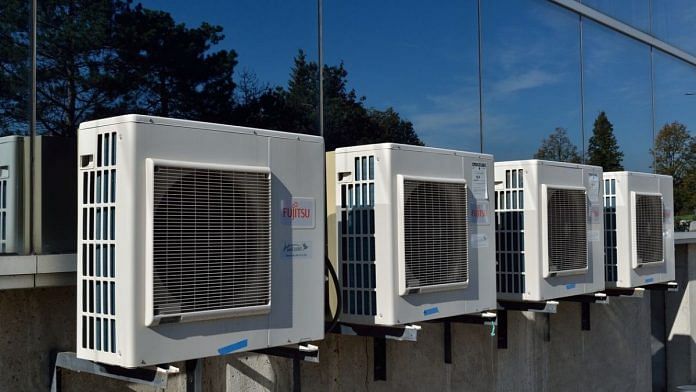
H eatwaves, floods, wildfires and other weather extremes – the signs of the climate crisis are all around us. But sustainable cooling could help beat the heat while cutting emissions. Rethinking how we stay cool could contribute to tackling today’s cooling paradox – in which heatwaves and extreme temperatures caused by the climate crisis send people in many parts of the world rushing to switch on air conditioning units, which release gases that further contribute to climate change.
As the name suggests, sustainable cooling is more climate-friendly than traditional refrigeration. It targets efficiency improvements to cooling solutions alongside measures that lower ambient temperatures in buildings and urban environments. Traditional air conditioners and refrigerants contain fluorinated gases that can leak, depleting the planet’s ozone layer and harming the environment .

Sustainable cooling replaces these gases with climate-friendly alternatives, which when coupled with enhanced energy-efficiency measures reduce both direct emissions from refrigerant leakage and indirect emissions from the energy used to power the cooling unit. According to the UN World Meteorological Organization, 2023 was the hottest year on record by a considerable margin . It’s therefore no surprise that climate change and nature’s collapse dominate the top 5 long-term threats identified in the World Economic Forum’s Global Risks Report 2024 .
As our planet’s atmosphere warms, heatwaves, soaring temperatures, droughts and other weather extremes are becoming both more frequent and more intense. Global warming has made simultaneous large heatwaves in the Northern Hemisphere six times more likely over the past 40-year period , according to research published in the Journal of the American Meteorological Society. Furthermore, cooling is critical to comfort, productivity and health.
Cooling is needed in agriculture to ensure food security and hospitals and healthcare centres need cooling to transport vaccines and other medical products. Here are three ways we can achieve sustainable cooling. A rethink of building designs and city layouts can play an important role in sustainable cooling.
Ambient cooling puts measures in place to help nature reduce the sun’s intensity, such as covering building roofs, balconies and other areas with plants and greenery to absorb heat, and fitting insulation and double glazing to block the sun’s heat. In urban areas, adding green spaces, installing shade cover and planning wide urban streets and low buildings to increase wind flow-through, are among the many measures that help to reduce heat gain. Some sustainable innovations, as explained by organization Sustainable Energy for All , use no operational energy or refrigerants.
These are sometimes referred to as nature-based or passive technology solutions. For instance, WAVIN (MetroPolder), a World Economic Forum Uplink innovator, builds green roofs that capture and store rainwater, which is recycled for use in cities . Captured rainwater is used for everything from irrigating the greenery on the roof, flushing the building’s toilets, and cooling the building during summer heat.
Urban climate-tech start-up BioShade reimagines how cityscapes look and feel, using AI, IoT and hydroponic technologies to autonomously generate natural shade. Roofs, walls and urban spaces become green, living organisms that create a cooler microclimate. Sustainable cooling can also leverage a more efficient use of refrigerants.
These technologies use certain types of refrigerants (such as ultra-low Global Warming Potential natural refrigerants) and depend on clean energy sources. Additionally, special features often help maximize the delivery of cool air, to save energy. New technologies are also playing a part , such as elastocalorics, described as “powering heat systems to work like muscles” in the Forum’s “Top 10 Emerging Technologies of 2024” report.
Heat pumps using elastocaloric materials such as nickel and titanium – emitting heat when mechanical stress is applied and cooling down when the stress is relaxed – are proving more energy-efficient than traditional heating and cooling systems. Cooling technologies like refrigeration and air-conditioning could account for two-fifths of Southeast Asia’s electricity demand by 2040 , according to a report called Freezing in the tropics: Asean’s air-con conundrum. Rapid growth in economic output, wealth and population density, and increasing migration to cities prompts heavy reliance on cooling solutions in the burgeoning economies of regions like Asia.
Driving progress on sustainable cooling requires a policy framework that encourages people, businesses and local governments to go green, including sustainable building codes and tax incentives, grants and subsidies to encourage take-up. According to the United Nations Environment Programme (UNEP) , policymakers can incentivize businesses to create energy-efficient cooling products, all while working sustainable cooling into climate pledges and ensuring that it is considered during the planning and design of energy, urban, transport, agricultural and health service projects. In its new report, Cooler Finance , UNEP identifies numerous private investment opportunities across the sector, including in refrigeration and transport.
“Sustainable cooling technologies are accessible, affordable and scalable and minimize environmental impact, aiming for near-zero emissions cooling by 2050 through increasing the use of passive strategies for cooling, raising energy efficiency standards and rules for cooling equipment, and accelerating the phasing down of highly polluting refrigerants.” Cooling currently contributes to 3.4% of global emissions .
Additionally, the International Energy Agency estimates that “Climate friendly cooling” could sidestep more than 460 billion tonnes of greenhouse gas emissions – or approximately eight years of global emissions at 2018 levels. Of course, there’s no one-size-fits-all solution to scale sustainable cooling. Tackling this issue will require a combination of strategies and empowering local leaders to work quickly to craft lasting solutions that work for their locality.
But while these steps will take leaders of all stripes in the right direction, urgent action is needed to address the underlying causes of climate change to keep global temperatures within the Paris Agreement climate target. This article previously appeared in the World Economic Forum. Save my name, email, and website in this browser for the next time I comment.
Δ document.getElementById( "ak_js_1" ).setAttribute( "value", ( new Date() ).
getTime() );.














